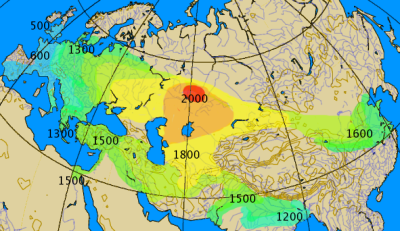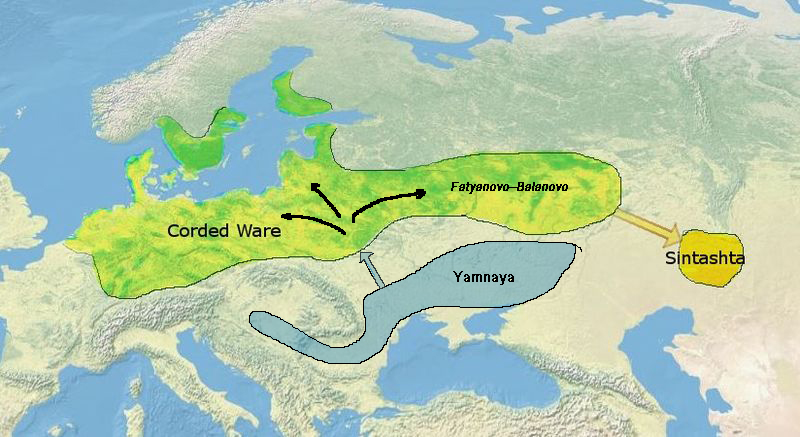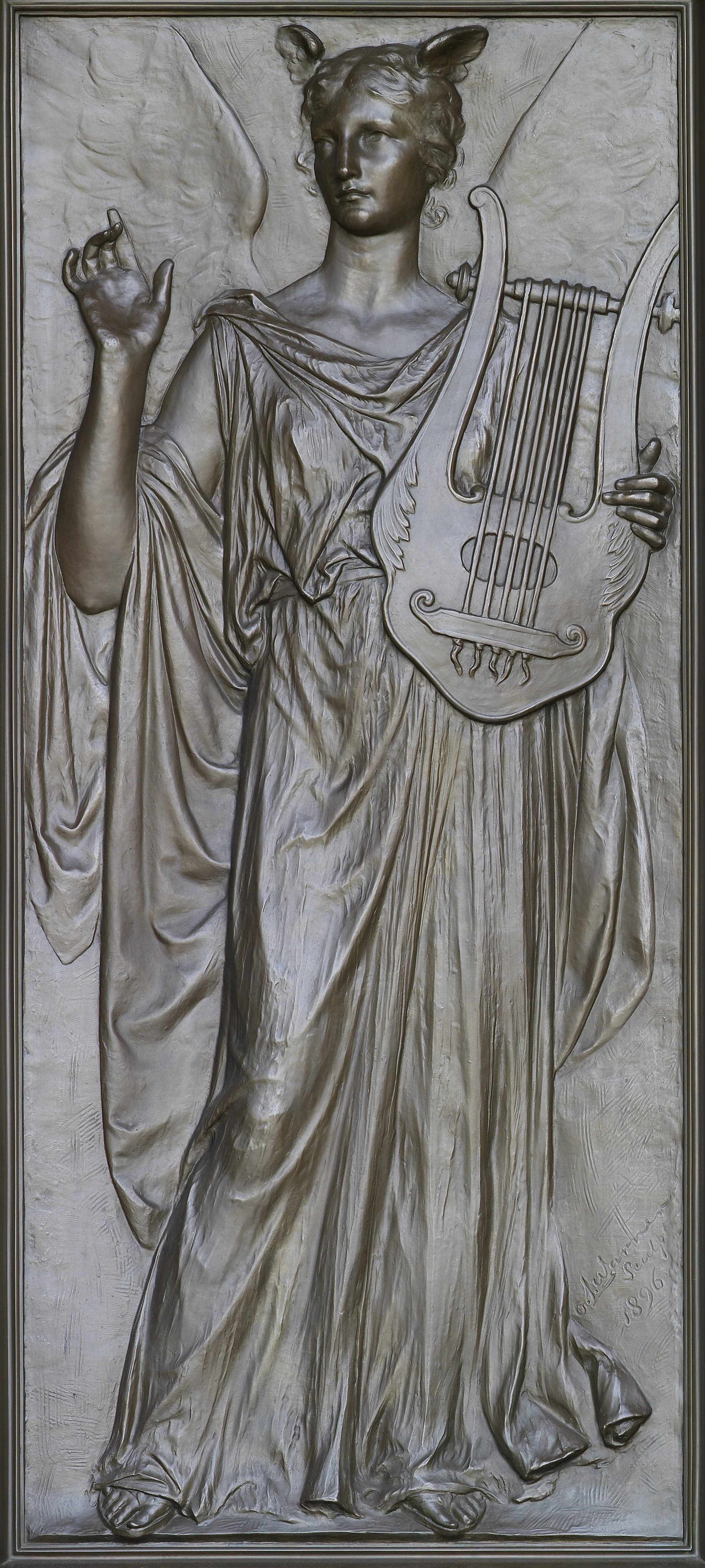|
Sinauli
Sinauli is an archaeological site in western Uttar Pradesh, India, at the Ganga-Yamuna Doab. The site gained attention for its Bronze Age solid-disk wheel carts, found in 2018, which were interpreted by some as horse-pulled "chariots". The excavations in Sinauli were conducted by Archaeological Survey of India (ASI) in 2005-06 and in mid-2018. The remains found in 2005–2006 season, the "Sanauli cemetery", belong to the Late Bronze Age, and were ascribed by excavation director Sharma to the Harappan civilisation, though a Late Harappan Phase or post-Harappan identification is more likely. Major findings from 2018 trial excavations are dated to c. 2000 - 1800 BCE, and ascribed to the Ochre Coloured Pottery culture (OCP)/ Copper Hoard Culture, which was contemporaneous with the Late Harappan culture. They include several wooden coffin burials, copper swords, helmets, and wooden carts, with solid disk wheels and protected by copper sheets. The carts were presented by Sanjay Man ... [...More Info...] [...Related Items...] OR: [Wikipedia] [Google] [Baidu] |
Sinauli Chariot ASI
Sinauli is an archaeological site in western Uttar Pradesh, India, at the Ganga-Yamuna Doab. The site gained attention for its Bronze Age solid-disk wheel carts, found in 2018, which were interpreted by some as horse-pulled Chariot, "chariots". The excavations in Sinauli were conducted by Archaeological Survey of India (ASI) in 2005-06 and in mid-2018. The remains found in 2005–2006 season, the "Sanauli cemetery", belong to the Late Bronze Age, and were ascribed by excavation director Sharma to the Harappan civilisation, though a Indus Civilisation, Late Harappan Phase or post-Harappan identification is more likely. Major findings from 2018 trial excavations are dated to c. 2000 - 1800 BCE, and ascribed to the Ochre Coloured Pottery culture (OCP)/Copper Hoard Culture, which was contemporaneous with the Late Harappan culture. They include several wooden coffin burials, copper swords, helmets, and wooden carts, with solid disk wheels and protected by copper sheets. The carts we ... [...More Info...] [...Related Items...] OR: [Wikipedia] [Google] [Baidu] |
Ochre Coloured Pottery Culture
The Ochre Coloured Pottery culture (OCP) is a Bronze Age culture of the Indo-Gangetic Plain "generally dated 2000–1500 BCE," extending from eastern Punjab to northeastern Rajasthan and western Uttar Pradesh. Artefacts of this culture show similarities with both the Late Harappan culture and the Vedic culture. Archaeologist Akinori Uesugi considers it as an archaeological continuity of the previous Harappan Bara style, while according to Parpola, the find of carts in this culture may reflect an Indo-Iranian migration into the India subcontinent, in contact with Late Harappans. The OCP marked the last stage of the North Indian Bronze Age and was succeeded by the Iron Age black and red ware culture and the Painted Grey Ware culture. Geography and dating The 'Ochre Coloured Pottery culture is "generally dated 2000-1500 BCE," Early specimens of the characteristic ceramics found near Jodhpura, Rajasthan, date from the 3rd millennium (this Jodhpura is located in the district of ... [...More Info...] [...Related Items...] OR: [Wikipedia] [Google] [Baidu] |
Ochre Coloured Pottery
The Ochre Coloured Pottery culture (OCP) is a Bronze Age culture of the Indo-Gangetic Plain "generally dated 2000–1500 BCE," extending from eastern Punjab to northeastern Rajasthan and western Uttar Pradesh. Artefacts of this culture show similarities with both the Late Harappan culture and the Vedic culture. Archaeologist Akinori Uesugi considers it as an archaeological continuity of the previous Harappan Bara style, while according to Parpola, the find of carts in this culture may reflect an Indo-Iranian migration into the India subcontinent, in contact with Late Harappans. The OCP marked the last stage of the North Indian Bronze Age and was succeeded by the Iron Age black and red ware culture and the Painted Grey Ware culture. Geography and dating The 'Ochre Coloured Pottery culture is "generally dated 2000-1500 BCE," Early specimens of the characteristic ceramics found near Jodhpura, Rajasthan, date from the 3rd millennium (this Jodhpura is located in the district of ... [...More Info...] [...Related Items...] OR: [Wikipedia] [Google] [Baidu] |
Chariot
A chariot is a type of cart driven by a charioteer, usually using horses to provide rapid motive power. The oldest known chariots have been found in burials of the Sintashta culture in modern-day Chelyabinsk Oblast, Russia, dated to c. 2000 BCE. The critical invention that allowed the construction of light, horse-drawn chariots was the spoked wheel. The chariot was a fast, light, open, two-wheeled conveyance drawn by two or more horses that were hitched side by side, and was little more than a floor with a waist-high guard at the front and sides. It was initially used for ancient warfare during the Bronze and Iron Ages, but after its military capabilities had been superseded by light and heavy cavalries, chariots continued to be used for travel and transport, in processions, for games, and in races. Etymology The word "chariot" comes from the Latin term ''carrus'', a loanword from Gaulish. In ancient Rome and some other ancient Mediterranean civilizations, a ''biga'' re ... [...More Info...] [...Related Items...] OR: [Wikipedia] [Google] [Baidu] |
Chariots
A chariot is a type of cart driven by a charioteer, usually using horses to provide rapid motive power. The oldest known chariots have been found in burials of the Sintashta culture in modern-day Chelyabinsk Oblast, Russia, dated to c. 2000 BCE. The critical invention that allowed the construction of light, horse-drawn chariots was the spoked wheel. The chariot was a fast, light, open, two-wheeled conveyance drawn by two or more horses that were hitched side by side, and was little more than a floor with a waist-high guard at the front and sides. It was initially used for ancient warfare during the Bronze and Iron Ages, but after its military capabilities had been superseded by light and heavy cavalries, chariots continued to be used for travel and transport, in processions, for games, and in races. Etymology The word "chariot" comes from the Latin term ''carrus'', a loanword from Gaulish. In ancient Rome and some other ancient Mediterranean civilizations, a ''biga'' requ ... [...More Info...] [...Related Items...] OR: [Wikipedia] [Google] [Baidu] |
Indo-Aryan Migrations
The Indo-Aryan migrations were the migrations into the Indian subcontinent of Indo-Aryan peoples, an ethnolinguistic group that spoke Indo-Aryan languages, the predominant languages of today's North India, Pakistan, Nepal, Bangladesh, Sri Lanka and the Maldives. Indo-Aryan population movements into the region from Central Asia are considered to have started after 2000 BCE, as a slow diffusion during the Late Harappan period, which led to a language shift in the northern Indian subcontinent. Several hundred years later, the Iranian languages were brought into the Iranian plateau by the Iranians, who were closely related to the Indo-Aryans. The Proto-Indo-Iranian culture, which gave rise to the Indo-Aryans and Iranians, developed on the Central Asian steppes north of the Caspian Sea as the Sintashta culture (2050Lindner, Stephan, (2020)"Chariots in the Eurasian Steppe: a Bayesian approach to the emergence of horse-drawn transport in the early second millennium BC" in Antiquity, ... [...More Info...] [...Related Items...] OR: [Wikipedia] [Google] [Baidu] |
Indigenous Aryans
Indigenous Aryanism, also known as the Indigenous Aryans theory (IAT) and the Out of India theory (OIT), is the conviction that the Aryans are indigenous to the Indian subcontinent, and that the Indo-European languages radiated out from a homeland in India into their present locations. It is a " religio-nationalistic" view on Indian history, and propagated as an alternative to the established migration model, which considers the Pontic–Caspian steppe to be the area of origin of the Indo-European languages. Reflecting traditional Indian views based on the Puranic chronology, indigenists propose an older date than is generally accepted for the Vedic period, and argue that the Indus Valley civilisation was a Vedic civilization. In this view, "the Indian civilization must be viewed as an unbroken tradition that goes back to the earliest period of the Sindhu-Sarasvati (or Indus) tradition (7000 or 8000 BCE)." Support for the IAT mostly exists among a subset of Indian schola ... [...More Info...] [...Related Items...] OR: [Wikipedia] [Google] [Baidu] |
Sonauli
Sonauli is a town, near city of Maharajganj in Maharajganj district in Uttar Pradesh, India. It located on the Indo-Nepal Border and is a well-known and most famous transit point between India and Nepal. Sonauli is around 75 km from district headquarter Mahrajganj, Uttar Pradesh. 90 km from Gorakhpur, which is the nearest major city. The nearest Railway station from Sonauli is Nautanwa Railway Station, which is around 7 km away and is now well connected with Indian Railway Network. Earlier Nautanwa was connected with Gorakhpur through Meter Gauge Railway Track. But with the development of Indian Railway Network, this track is converted into Broad gauge which facilitate fast long railway transit. Sonauli India–Nepal Border Crossing The Sonauli India–Nepal border crossing or Sonauli Integrated Check Post in Uttar Pradesh is the most popular and designated Integrated Check Posts (ICP), with both customs and immigration facilities:http://www.mdoner.gov.in/node/1483 IC ... [...More Info...] [...Related Items...] OR: [Wikipedia] [Google] [Baidu] |
Ratha
Ratha ( Proto-Indo-Iranian: ''*Hrátʰas'', Sanskrit: रथ, '; Avestan: ''raθa'') is also known as the Indo-Iranian term for a spoked-wheel chariot or a cart of antiquity. Harappan Civilisation The Indus Valley Civilization sites of Daimabad and Harappa in the Indian subcontinent, there is evidence for the use of terracotta model carts as early as 3500 BC during the Ravi Phase. There is evidence of wheeled vehicles (especially miniature models) in the Indus Valley Civilization, but not of chariots. According to Kenoyer, Indo-Aryan Indigenists have argued for the presence of chariots before its introduction by the Indo-Aryans in the early 2nd millennium BCE. Archaeologist B. B. Lal argues that finds of terracotta wheels painted lines (or low relief lines) and similar seals indicate the existence and use of spoked wheel chariots in Harappan Civilization, as showed in the Bhirrana excavations in 2005–06. Bhagwan Singh has made a similar assertion and S.R. Rao has presen ... [...More Info...] [...Related Items...] OR: [Wikipedia] [Google] [Baidu] |
Neeraj Pandey
Neeraj Pandey (born 17 December 1973) is an Indian film director, producer and screenwriter who works in Hindi cinema. Pandey was made his directoral debut in ''A Wednesday!'', which was largely praised by critics and which later became a recipient of many accolades. His second film was ''Special 26'' (2013), which was followed by ''Baby (2015 Hindi film), Baby'' (2015), the latter of which received critical acclaim and became a huge commercial success. He served as a producer in ''Rustom (film), Rustom'' (2016). Pandey returned to directing in 2016 helming the biopic movie ''M.S. Dhoni: The Untold Story'' based on Indian cricketer MS Dhoni, M.S.Dhoni which fared well critically and commercially. Besides being a filmmaker, Pandey is also a writer and has written a novel named ''Ghalib Danger'' in 2013. In 2016, his production house Friday Filmworks entered into a joint venture with Reliance Entertainment and formed Plan C Studios. He has also directed a Web Short 'Ouch' with Ma ... [...More Info...] [...Related Items...] OR: [Wikipedia] [Google] [Baidu] |
Imagination Of Coffin Burial 1 Of Sinauli
Imagination is the production or simulation of novel objects, sensations, and ideas in the mind without any immediate input of the senses. Stefan Szczelkun characterises it as the forming of experiences in one's mind, which can be re-creations of past experiences, such as vivid memories with imagined changes, or completely invented and possibly fantastic scenes. Imagination helps make knowledge applicable in solving problems and is fundamental to integrating experience and the learning process.Norman 2000 pp. 1-2Brian Sutton-Smith 1988, p. 22 Kieran Egan 1992, pp. 50 As an approach to build theory, it is called "disciplined imagination". A basic training for imagination is listening to storytelling (narrative), in which the exactness of the chosen words is the fundamental factor to "evoke worlds". One view of imagination links it with cognition, seeing imagination as a cognitive process used in mental functioning. It is increasingly used - in the form of visual imagery - by clini ... [...More Info...] [...Related Items...] OR: [Wikipedia] [Google] [Baidu] |
Terracotta
Terracotta, terra cotta, or terra-cotta (; ; ), in its material sense as an earthenware substrate, is a clay-based ceramic glaze, unglazed or glazed ceramic where the pottery firing, fired body is porous. In applied art, craft, construction, and architecture, terracotta is the term normally used for sculpture made in earthenware and also for various practical uses, including bowl (vessel), vessels (notably flower pots), water and waste water pipes, tile, roofing tiles, bricks, and surface embellishment in building construction. The term is also used to refer to the natural Terra cotta (color), brownish orange color of most terracotta. In archaeology and art history, "terracotta" is often used to describe objects such as figurines not made on a potter's wheel. Vessels and other objects that are or might be made on a wheel from the same material are called earthenware pottery; the choice of term depends on the type of object rather than the material or firing technique. Unglazed ... [...More Info...] [...Related Items...] OR: [Wikipedia] [Google] [Baidu] |









.jpg)